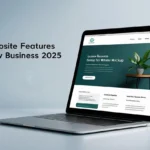In today’s digital age, a well-designed website is no longer a luxury but a necessity, especially for professional services. Whether you’re a lawyer, consultant, or architect, your website is often the first point of contact for potential clients. With the ever-growing competition in the digital space, it’s crucial to have a website that not only stands out but also effectively communicates your brand’s message. One of the most effective ways to achieve this is through minimalist website design.
Minimalist design has gained popularity in recent years, and for a good reason. It focuses on simplicity, functionality, and clarity—qualities that are essential for professional services. In this blog post, we’ll explore the art of minimalist website design, its benefits, key principles, and how it can help professional services make a lasting impression.
Why Minimalist Design Works for Professional Services
1. Clarity and Focus
Minimalist design is all about stripping away the unnecessary and focusing on what’s important. For professional services, this means highlighting your expertise, services, and contact information without overwhelming visitors with excessive visuals or content. A clean, uncluttered design helps your potential clients quickly understand who you are, what you do, and how you can help them.
2. Enhanced User Experience
User experience (UX) is a critical factor in website design, and minimalism excels in this area. By reducing the number of elements on a page, you create a more straightforward navigation experience for your visitors. This makes it easier for them to find the information they need, whether it’s your service offerings, testimonials, or contact details. A well-designed, minimalist website ensures that visitors can navigate your site with ease, leading to higher engagement and conversion rates.
3. Faster Loading Times
In a world where attention spans are shrinking, website speed is more important than ever. A minimalist design, with its focus on simplicity, typically results in faster loading times. This is because there are fewer images, scripts, and other elements that can slow down a website. A fast-loading website is not only beneficial for user experience but also for search engine optimization (SEO). Search engines like Google prioritize fast-loading sites, which can help improve your search rankings.
Ready to take your professional services to the next level with a minimalist website design? Contact Graphix Studio, a leading Website Design Company in Lucknow, to get started today! Check Out Our affordable Startup website design plan 4999
Key Principles of Minimalist Website Design
1. Simplicity
At its core, minimalism is about simplicity. This doesn’t mean your website should be bare-bones, but rather that every element on the page should serve a purpose. Avoid clutter and focus on the essentials—your services, contact information, and a clear call to action. Use white space effectively to create a clean and open feel, which helps guide the visitor’s eye to the most critical parts of your website.
2. Visual Hierarchy
Visual hierarchy is a fundamental principle in design, and it’s especially important in minimalism. It involves arranging elements on the page in a way that guides the visitor’s attention in a logical order. For example, your headline should be the most prominent element, followed by subheadings, body text, and images. By establishing a clear visual hierarchy, you ensure that your visitors can easily scan your content and find the information they’re looking for.
3. Consistency
Consistency is key to creating a cohesive and professional-looking website. This means using the same fonts, colors, and design elements throughout your site. A consistent design not only looks more polished but also helps reinforce your brand identity. For professional services, this is crucial as it builds trust and credibility with your audience.
4. Use of White Space
White space, also known as negative space, is the empty space around elements on a page. In minimalist design, white space is used strategically to create a sense of balance and harmony. It helps prevent your website from feeling cluttered and makes it easier for visitors to focus on the content. White space also enhances readability, making it easier for visitors to consume your content without feeling overwhelmed.
5. Typography
In a minimalist design, typography plays a significant role. Since there are fewer visual elements, the text becomes a primary focus. Choose fonts that are clean, easy to read, and align with your brand’s personality. Consider using different font weights and sizes to create contrast and hierarchy. Remember, the goal is to make your content easy to read and digest.
Looking for a minimalist design that reflects your professionalism? Let Graphix Studio, your trusted Web Design Company in Lucknow, craft a website that sets you apart from the competition. Contact us today!
How to Implement Minimalist Design in Professional Services Websites
1. Focus on Core Content
When designing a minimalist website for professional services, start by identifying the core content you want to highlight. This typically includes your services, portfolio, testimonials, and contact information. Once you’ve identified these key elements, design your website around them, ensuring that each element is given the appropriate amount of attention.
2. Limit Color Palette
Minimalist design often features a limited color palette, usually consisting of two to three colors. This not only creates a clean and cohesive look but also helps to reinforce your brand identity. For professional services, it’s best to stick to neutral or muted tones, which convey a sense of professionalism and sophistication. You can use a single accent color to draw attention to important elements like call-to-action buttons.
3. Prioritize Mobile Responsiveness
With more people accessing websites on their mobile devices, it’s crucial that your minimalist design is mobile-friendly. A responsive design ensures that your website looks and functions well on all screen sizes. Since minimalist design naturally involves fewer elements, it often adapts better to smaller screens. However, it’s essential to test your design on various devices to ensure a seamless user experience.
4. Optimize Images and Multimedia
While minimalist design typically involves fewer images and multimedia elements, the ones you do use should be high-quality and optimized for fast loading. Avoid using large, uncompressed images that can slow down your site. Instead, opt for smaller, compressed images that load quickly without compromising quality. When using videos, ensure they are optimized for web use and consider using lazy loading techniques to improve performance.
5. Clear Calls to Action
In a minimalist design, calls to action (CTAs) are more important than ever. Since there are fewer distractions on the page, your CTAs should stand out and be easy to find. Use contrasting colors, larger fonts, or buttons to draw attention to your CTAs. Make sure your message is clear and compelling, encouraging visitors to take the next step, whether it’s contacting you, booking a consultation, or signing up for a newsletter.
The Benefits of Minimalist Design for SEO
Minimalist design isn’t just about aesthetics; it also offers several SEO benefits that can help improve your website’s search engine rankings. Here’s how:
1. Faster Loading Times
As mentioned earlier, minimalist websites typically load faster due to fewer elements on the page. Since page speed is a ranking factor for search engines, a faster website can help boost your rankings. Moreover, faster loading times lead to lower bounce rates, as visitors are less likely to leave your site due to slow load times.
2. Improved User Experience
Search engines prioritize websites that offer a good user experience, and minimalism excels in this area. A clean, easy-to-navigate website encourages visitors to stay longer and explore more pages. This increased engagement can lead to higher rankings, as search engines interpret it as a sign of valuable content.
3. Mobile-Friendliness
With the growing importance of mobile search, having a mobile-friendly website is essential for SEO. Minimalist designs often translate well to mobile devices, making it easier to achieve a responsive design. A mobile-friendly website not only improves user experience but also helps you rank higher in mobile search results.
4. Focused Content
Minimalist design encourages you to focus on the most critical content, which can be beneficial for SEO. By emphasizing your key services, you can naturally incorporate relevant keywords into your content without resorting to keyword stuffing. This helps search engines better understand your website’s purpose and relevance to specific search queries.
Conclusion
Minimalist website design is more than just a trend—it’s a powerful approach to creating professional, effective websites that resonate with your target audience. By focusing on simplicity, clarity, and functionality, you can create a website that not only looks great but also delivers a superior user experience. Whether you’re a lawyer, consultant, or architect, a minimalist design can help you stand out in a crowded market and make a lasting impression on potential clients.
If you’re ready to elevate your online presence with a minimalist website, look no further than Graphix Studio. As a top-tier Website Design Company in Lucknow, we have the expertise and creativity to bring your vision to life. Contact us today to start your journey toward a cleaner, more effective website.










